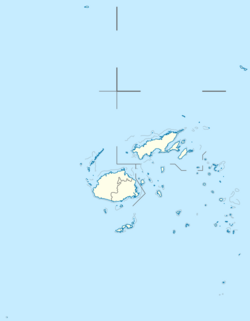Unsolved:Ndakunimba Stones
Vatu Vola | |
| Location | Ndakunimba/Dakuniba Village, Cakaudrove Province, Vanua Levu, Fiji |
|---|---|
| Coordinates | [ ⚑ ] : 16°44′42″S 179°50′53″E / 16.745°S 179.848°E |
| Type | Rock art/petroglyphs |
| History | |
| Material | Stone |
| Founded | c. 500 BC |
| Cultures | Lapita culture |
| Events | Settling of Fiji |
| Site notes | |
| Discovered | 1934 - 1937 |
| Archaeologists | Bruce and Sheridan Fahnestock |
| Condition | 14 fragments |
<mapframe height="200" zoom="15" text="Ndakunimba Village on Vanua Levu" width="300">{"type":"Feature","geometry":{"coordinates":[[179.848,-16.744101684715886],[179.84781698783783,-16.744118945511538],[179.84764100863404,-16.74417006458498],[179.84747882508907,-16.744253077485027],[179.847336669771,-16.74436479411159],[179.8472200056098,-16.7445009213035],[179.847133315963,-16.74465622781526],[179.8470799323196,-16.744824745343827],[179.8470619062648,-16.744999997881227],[179.84707993062614,-16.745175250579912],[179.8471333128339,-16.74534376856777],[179.8472200015215,-16.74549907576691],[179.8473366653458,-16.74563520376964],[179.84747882100075,-16.745746921207026],[179.84764100550498,-16.74582993479445],[179.84781698614438,-16.74588105432719],[179.848,-16.745898315284123],[179.84818301385565,-16.74588105432719],[179.84835899449504,-16.74582993479445],[179.84852117899928,-16.745746921207026],[179.84866333465422,-16.74563520376964],[179.84877999847853,-16.74549907576691],[179.84886668716612,-16.74534376856777],[179.8489200693739,-16.745175250579912],[179.84893809373523,-16.744999997881227],[179.84892006768044,-16.744824745343827],[179.84886668403703,-16.74465622781526],[179.8487799943902,-16.7445009213035],[179.84866333022902,-16.74436479411159],[179.84852117491096,-16.744253077485027],[179.84835899136596,-16.74417006458498],[179.8481830121622,-16.744118945511538],[179.848,-16.744101684715886]],"type":"LineString"},"properties":{"stroke-width":6,"stroke":"#ff0000","title":"Ndakunimba Stones","description":"Ndakunimba"}}</mapframe>
The Ndakunimba Stones are the remains of a 50-foot-tall monolith carved with petroglyphs, located in Dakuniba (Template:IPA-fj, Script error: The function "transl" does not exist.), a remote village in Cakaudrove Province on Vanua Levu, Fiji. They comprise about 14 stone fragments of various sizes, with deeply carved angular figures.[1]
The stones were discovered by Bruce and Sheridan Fahnestock on expeditions between 1934 and 1937 for the American Museum of Natural History. While the petroglyphs were at first thought to have been an early notational system, they have yet to be deciphered.[2]
Origins
The origins of the stones are uncertain. A local legend from Viti Levu has that Vanua and Viti were once one island. Currently, the two islands are 30 miles apart, with deep water in-between. Supposedly this island had a written language. After the island split apart, the men of Viti Levu tried to carry records of the language to the other half, now Vanua Levu, by loading monoliths with carved symbols into canoes. The canoes sank before reaching Vanua Levu, but were bound for a spot near Nadakunimba. The Fahnestock brothers searched there and found one monolith, which fit the descriptions in the legend. It had been set originally on the side of a hill, but had fallen back against the hill and broken into several fragments. One of these the Fahnestocks estimated to have weighed 40 tons.[3]
Other legends by the local Mabuco people refer to the stones as the "Vatu Vola", and say it was transported on the Rogovoka[lower-alpha 1] on its last voyage from Verata. The ship had also transferred sacred rocks to the king of Tonga before coming to Fiji. This legend says the monolith was originally a statue but crumbled from years of exposure. After the Vatu Vola was erected, the ship was sunk so that the ship, which reached from Nadakunimba to Vunisavisavi Village, could not be used to find the Vatu Vola.[5] Other petroglyphs (ivakatakilakila or signs of Lewaqoroqoro) in the sea caves at Sawa-i-Lau off Yasawa island are supposed to be similar.[6] Another site named Vatu Vola has also been identified at Moturiki, although the carvings are different.[7]
Identification attempts
Originally the Fahnestocks believed that the symbols were Chinese, and officials at the Fiji Museum in Suva assured them that this was true, but scholars in China disproved this. [3]
In 2016, a team of scientists from Israel visited the site and identified one character as similar to the Hebrew letter Yodh (Hebrew: י).[5]
Notes
References
- ↑ Cruz Berrocal, María; Millerstrom, Sidsel (September 2013). "The archaeology of rock art in Fiji: evidence, methods and hypotheses". Archaeology in Oceania 48 (3): 154–165. doi:10.1002/arco.5017. https://www.researchgate.net/publication/259535617.
- ↑ James McKee (Spring 1998). "South Sea Collection Comes to Folk Archive". Folklife Center News X (2): p. 5. https://books.google.com/books?id=EjbYAAAAMAAJ&q=Ndakunimba&pg=RA1-PA4.
- ↑ 3.0 3.1 "LOST WORLD CLUE FOUND IN PACIFIC" (in en). Rapid City Journal (Rapid City, South Dakota): p. 10. November 6, 1937. https://www.newspapers.com/clip/110517392/lost-world-clue-found-in-pacific/.
- ↑ Who was Ravuravu? citing Rokowaqa, Rev Epeli (2013). Meo, Kolinio Rainima. ed. Viti Makawa : (the history of the native Fijians). Suva, Fiji: Dravucevua Enterprise. ISBN 9789829808615.
- ↑ 5.0 5.1 Serafina Silaitoga (December 24, 2017). "Mysterious writings at Dakuniba". Fiji Times. https://www.fijitimes.com/mysterious-writings-at-dakuniba/.
- ↑ Aubrey Parke (2014). "The Tikina of Yasawa". Degei's Descendants: Spirits, Place and People in Pre-Cession Fiji. 41. ANU Press. ISBN 9781925021813. https://press-files.anu.edu.au/downloads/press/p289571/html/ch13.xhtml?page=21.
- ↑ BERROCAL, MARÍA CRUZ; GONZÁLEZ, ANTONIO URIARTE; MILLERSTROM, SIDSEL; RODRÍGUEZ, SUSANA CONSUEGRA; PÉREZ-ARIAS, JUANA; ORMEÑO, SANTIAGO (2014). "Archaeological History of a Fijian Island: Moturiki, Lomaiviti Group". Asian Perspectives 53 (2): 162–194. ISSN 0066-8435. https://scholarspace.manoa.hawaii.edu/bitstream/10125/42778/1/03_AP_53.2berrocal%20et%20al.pdf.
Sources and further reading
- THE FAHNESTOCK SOUTH SEA COLLECTION
- Bruce and Sheridan Fahnestock (1938), Stars to Windward. Harcourt, Brace and Co. OCLC 1693275
- Mary Sheridan Fahnestock (1939) I Ran Away to Sea at Fifty. Harcourt, Brace OCLC 1268265
- Bob Martin (August 22, 2013). The Mysterious Stones of Ndakunimba: A Discovery of the Fahnestock South Seas Expedition. Distributed via Smashwords. ISBN 9781301017195.
- "LOST WORLD CLUE FOUND IN PACIFIC: Swastika-Like Symbols Are discovered by South Seas Expedition". Pittsburgh Daily Press. October 20, 1937. https://www.unexplained-mysteries.com/forum/topic/237545-the-ndakunimba-stones/.
External links
- Nature tours at Daku Resort "Dakuniba: the ancient fallen monoliths"
 |


